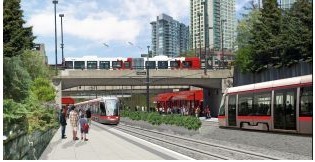
With the procurement of
Transit vehicles purchased with provincial funding must contain at least 25-per-cent Canadian content under a provincial policy that came into effect in 2008.
Siemens – which won the contract to construct
In an interview, Mr. Chiarelli at first said the 25-per-cent domestic content provision would apply to bidders on
But when questioned further, he said the province may adjust the rules.
“That 25-per-cent requirement has been on the table in discussions,” he said.
“We’re in a situation of evolution and everything is up for discussion … There is nothing carved in stone. We like to find the sweet spot for what makes sense for
Adjusting provincial domestic content provisions would not only affect the bids on Ottawa’s transit project, but also other Ontario municipalities preparing to construct light-rail lines, such as the Region of Waterloo.
Bombardier, which manufactures rail vehicles in
A spokesperson for Siemens, which manufacturers its light-rail vehicles in Sacramento, Calif., said allowing more foreign content in Ottawa’s light-rail line would save the city money.
“An amended policy will not only serve Siemens, but all other LRT vehicle suppliers,” said DL Leslie in a written response to questions.
“Only Bombardier has a facility in
Mr. Leslie noted Siemens has 5,000 Canadian employees and is expanding its manufacturing presence in
The Canadian Auto Workers will likely oppose any changes that loosen
The CAW notes that south of the border, the Buy America Act requires 60-per-cent domestic content for federally funded public transit purchases, and 100-per-cent domestic content for material inputs such as iron and steel.
In
Many major transit vehicle manufacturers have structured their global operations to comply with domestic content regulations around the world. This has some questioning whether a change to
City officials took the first step in procuring this city’s light-rail line when they published a request for qualifications from interested firms late last month.
Companies have until September to respond to the RFQ. A shortlist of qualified firms will be published the following month.
Those companies will then have nine months to respond to the full request for proposals. A final contract is expected to be signed by December 2012.
Last week, the city announced the underground tunnel would run beneath
The move means the tunnel will be much closer to the surface and reduces the estimated cost of the line from $2.1 billion to $1.74 billion.
Both figures are in 2009 dollars, meaning the final price will rise with inflation.
What’s considered a Canadian vehicle?
The Canadian content of a transit vehicle is calculated as a percentage of the total final costs to the manufacturer, less taxes. Eligible costs include labour, subcomponents and components, project management, engineering, manuals, special tools, test equipment, freight and warranty.


